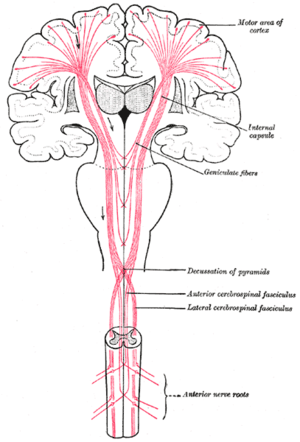Tractus corticospinalis
It belongs to the direct cortical motor pathways. It starts in the motor and sensory cortex and ends in the spinal cord. In English, it's called the pyramidal pathway.
Description[edit | edit source]
The pyramidal pathway is single-neuron. 60% of the pathway leads from the motor cortex (area 4, 6) and 40% from the sensory cortex (area 5, 7). The pathway terminates in spinal segments on motoneurons and interneurons of the anterior horns and also on neurons of the posterior horns. The somatotopic arrangement, or cortical homunculus, is also reflected in the pathway. The pathway consists of layer V pyramidal cells and their axons.
Function[edit | edit source]
The function of the pyramidal pathway is free motor movement, especially fine motor movement of the distal parts of the limbs.
Malfunction[edit | edit source]
Disruption of the pathway leads to secondary limb hemiplegia. The muscles of the trunk are usually unaffected.
Hemiplegia alternans may also occur. This is a hemiplegia accompanied by cranial nerve palsies. This is because the fibers of the cranial nerves run close to the pyramidal pathway.
Course[edit | edit source]
The pathway emerges from the cortex, runs through the capsula interna, where it passes just behind the genu capsulae internae. It then runs down the middle of the crura cerebri and continues to the basal part of the pontus, where it forms bundles between the nuclei pontis. At the transition of the oblongata and spinal cord, the pathways merge into a single bundle to form the pyramides medullae oblongatae. Subsequently, the pathways cross, called decussatio pyramidum. The pathway crosses in 80%, the remaining part crosses only in the spinal segment.
The crossed part then continues as the tractus corticospinalis lateralis to the lateral spinal cords and the uncrossed part as the tractus corticospinalis anterior to the anterior horns of the spinal cord.
End[edit | edit source]
The pathway ends gradually in the spinal segments. Part of the motor cortex ends anteriorly in the spinal cord: in Rexed zone VII (on interneurons) and Rexed zone IX (on motoneurons). Part of the sensory cortex ends in the posterior columns of the spinal cord: in Rexed zones IV-VI.
Links[edit | edit source]
Related articles[edit | edit source]
External links[edit | edit source]
Citations[edit | edit source]
- ČIHÁK, – GRIM, Miloš. Anatomie 3. 2. edition. Grada, 2004. 673 pp. ISBN 80-247-1132-X.
- PETROVICKÝ, Pavel. Anatomie s topografií a klinickými aplikacemi : III. svazek, Neuroanatomie, smyslová ústrojí a kůže. 1. edition. Osveta, 2002. 542 pp. 3; ISBN 80-8063-048-8.



